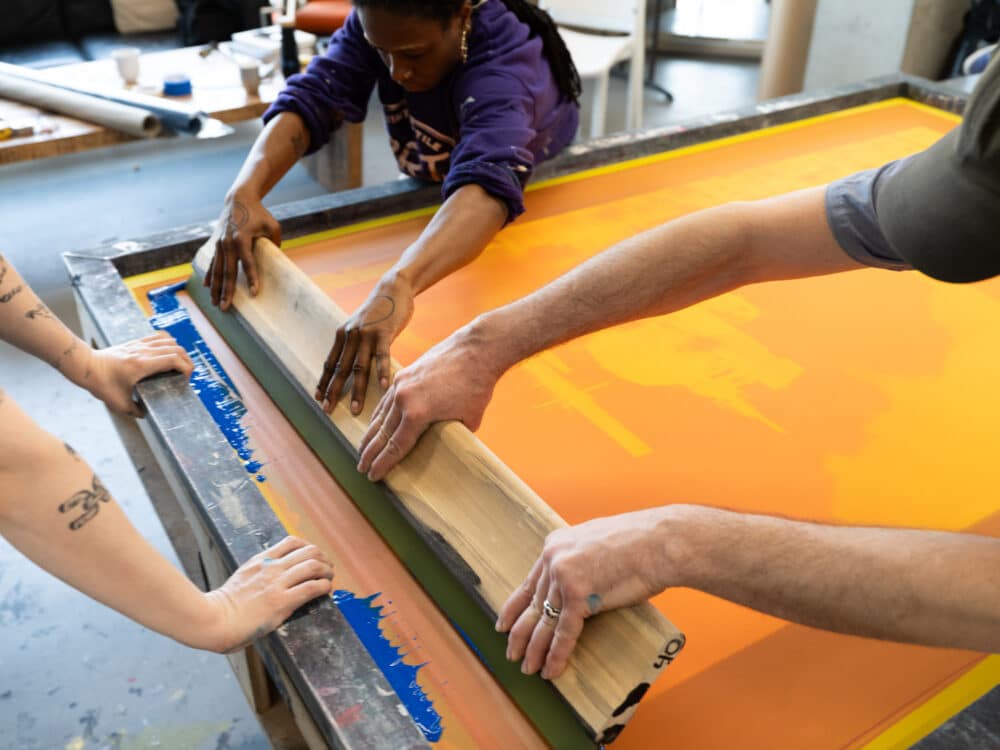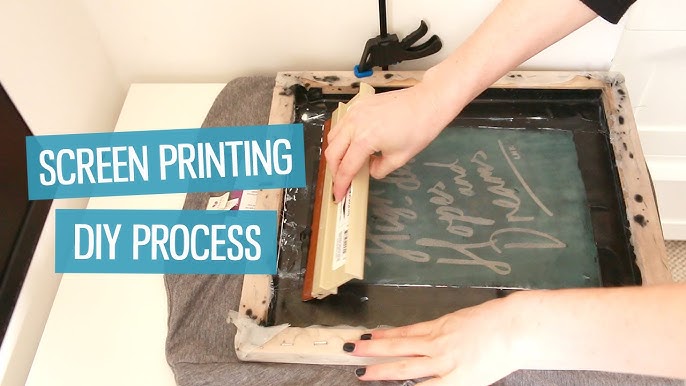ChatGPT said: Finding the best deals with 10:9 Design near me: strategies
Wiki Article
Discover the Various Kinds Of Screen Printing Techniques for Your Next Project
Screen printing offers a varied variety of methods that can improve any creative task. From typical approaches like serigraphy to contemporary advancements such as direct-to-garment printing, each strategy has its special advantages. Specialty choices, including metal and environment-friendly inks, present a lot more possibilities. Understanding these methods can considerably affect the final outcome. The difficulty exists in choosing the most appropriate technique for details requirements and preferred effects. What variables should one take into consideration?
The Essentials of Screen Printing
Screen printing might appear facility, it is essentially an uncomplicated procedure that includes moving ink with a mesh screen onto different surface areas. The technique starts with the creation of a pattern, which defines the layout to be published. This pattern is affixed to a mesh screen, generally made from polyester or nylon. As soon as the stencil is in place, ink is put on the screen and pressed via the mesh utilizing a squeegee, causing the desired pattern being printed on the underlying product.Screen printing can be performed on a large range of substratums, including fabric, paper, and plastic, making it a versatile selection for different jobs. The process enables complex styles and lively shades, making it preferred in markets such as advertising and marketing, fashion, and art. Recognizing these basics outfits people with the fundamental expertise needed to explore advanced techniques in screen printing.
Traditional Screen Printing Techniques
Conventional screen printing methods have actually been used for centuries, preserving the craftsmanship and artistry of this technique. This method utilizes a mesh screen to transfer ink onto a substrate, such as material or paper, permitting for long-lasting and vivid styles. The process starts with producing a pattern, which obstructs certain locations of the screen to manage where the ink will certainly be applied.One prominent strategy is serigraphy, usually made use of for limited editions and imaginative prints. One more is the usage of water-based inks, which are green and provide a soft feeling on fabrics - 10:9 Design Screen Printing. Additionally, conventional techniques can include hands-on printing, where artisans use ink with a squeegee, ensuring precision and attention to information
These techniques continue to be valued in the industry for their responsive high quality and the unique appearances they produce, appealing to both consumers and creators who appreciate the heritage of screen printing.
Digital Screen Printing Innovations
As the demand for faster production and modification in the printing market has actually risen, electronic screen printing developments have actually become a game-changer. This technology mixes conventional screen printing approaches with digital processes, allowing for quick prototyping and detailed styles that were formerly challenging to accomplish. One substantial development is the intro of direct-to-garment (DTG) printing, which promotes high-quality, full-color prints on different textiles without the demand for screens. Additionally, advancements in ink solutions have caused eco-friendly alternatives that keep lively colors while reducing ecological effect. Making use of automated systems further simplifies production, reducing labor costs and improving accuracy. These technologies not only accommodate small set orders and tailored styles however also permit quicker turn-around times, making them ideal for companies concentrated on meeting consumer demands in a busy market. Digital screen printing, as a result, stands for a crucial advancement in the domain of printing strategies.Specialty Screen Printing Methods
Checking out specialized screen printing techniques exposes a varied array of strategies that push the borders of creative thinking and functionality in the printing sector. Amongst these, glow-in-the-dark inks offer a distinct aesthetic effect, making styles come active in low-light conditions. Metallic inks, understood for their sparkling finish, include a touch of deluxe to published products. An additional cutting-edge approach is discharge printing, which eliminates color from the material as opposed to adding ink, causing a soft, classic feel. High-density printing produces an increased texture externally, improving tactile engagement. Additionally, water-based inks are getting popularity for their lively colors and minimized environmental effect. Each of these specialized strategies deals with particular layout demands, enabling artists and brand names to produce standout items that reverberate with their audiences. By leveraging these techniques, services can raise their screen printing tasks to new elevations, making sure memorable impressions.Eco-Friendly Screen Printing Options
Environmentally friendly screen printing options are acquiring traction as the sector moves towards sustainability. Lasting ink choices and using eco-friendly materials are key elements in decreasing the environmental impact of the printing procedure. By embracing these methods, screen printers can add to a much more sustainable future while preserving high-quality outcomes.Sustainable Ink Selections

Biodegradable Products Use
As the screen printing industry develops, the incorporation of eco-friendly materials is becoming significantly important for environmentally mindful practices. Manufacturers and developers are currently checking out inks and substrates made from natural, renewable energies that decay much more efficiently than typical equivalents. These naturally degradable options reduce plastic waste and reduce environmental influence, straightening with the expanding demand for lasting products.
Common examples consist of water-based inks and natural cotton materials, both of which minimize damaging chemicals and advertise eco-friendliness. Brand names that embrace these materials usually improve their market appeal, bring in consumers who focus on sustainability. As recognition of environmental concerns proceeds to rise, the shift towards biodegradable materials in screen printing is most likely to gain momentum, window sign printing promoting a greener market requirement.
Choosing the Right Method for Your Job
Exactly how can one figure out the most suitable screen printing method for a details task? The decision pivots on numerous factors, including the material to be printed on, the complexity of the design, and the preferred production quantity - 10:9 Design contact. For example, direct-to-garment printing is excellent for complex styles with many colors, while traditional screen printing excels for larger runs of easier graphics
In addition, consideration of the end-use of the printed product is necessary. For outdoor applications, techniques that use sturdiness and weather condition resistance, such as plastisol ink, might be favored. Conversely, environmentally-conscious jobs may take advantage of water-based inks or eco-friendly materials.
Ultimately, comprehending the project's one-of-a-kind requirements permits an educated choice, making sure both aesthetic allure and practical long life. By examining layout complexity, material compatibility, and manufacturing range, one can properly select the most proper screen printing strategy to fulfill their project's goals.
Regularly Asked Questions
What Is the History of Screen Printing?
Screen printing came from in ancient China around 1000 AD, developing via Japan and Europe. By the 20th century, it ended up being popular in commercial art and fashion, reinventing exactly how layouts were created and dispersed internationally.
How Do I Prepare Artwork for Screen Printing?
To prepare artwork for screen printing, one have to assure high resolution, make use of an appropriate color mode, produce different layers for each shade, and convert message to lays out, ensuring compatibility with the printing process and preferred outcome.What Materials Are Finest for Screen Printing?
The most effective materials for screen printing consist of top quality inks, resilient screens, and suitable substrates like cotton, polyester, or blends. Additionally, using proper emulsion and mops can boost the printing procedure and results.Can I Screen Print in your home?
Yes, screen printing at home is feasible. With the ideal products, setup, and strategies, individuals can develop top notch prints. However, mindful consideration of work area and tools is crucial for effective outcomes.
What Are Common Errors in Screen Printing?
Common errors in screen printing consist of improper direct exposure times, inadequate ink uniformity, misalignment of displays, insufficient cleaning of products, and neglecting to examine prints. These mistakes can endanger the quality and precision of the end product.Screen printing might appear complex, it is essentially an uncomplicated process that includes transferring ink with a mesh screen onto different surfaces. As the demand for faster production and personalization in the printing sector has actually risen, electronic screen printing technologies have actually arised as a game-changer. Discovering specialty screen printing approaches discloses a varied variety of methods that push the boundaries of creativity and performance in the printing market. The best materials for screen printing include high-quality inks, resilient displays, and appropriate substratums like cotton, polyester, or blends (10:9 Design Abilene). Usual mistakes in screen printing consist of incorrect exposure times, insufficient ink consistency, imbalance of displays, inadequate cleansing of products, and neglecting to test prints
Report this wiki page